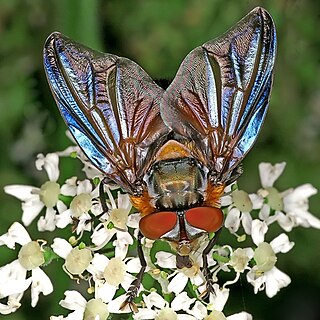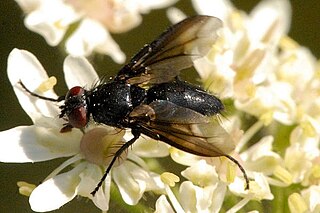
Blepharipa is a genus of flies in the family Tachinidae.
Chetogaster is a genus of flies in the family Tachinidae.
Chlorotachina is a genus of flies in the family Tachinidae.
Austrophorocera is a genus of flies in the family Tachinidae.
Formosia is a genus of flies in the family Tachinidae.

Microtropesa is a genus of flies in the family Tachinidae.

Peleteria is a widespread genus of flies in the family Tachinidae.

Phasia is a genus of flies in the family Tachinidae.
Prodiaphania is a genus of flies in the family Tachinidae.

Prosena is a genus of flies in the family Tachinidae.

Rutilia is a large genus of medium to large (>20mm) flies in the family Tachinidae native to Australia and the Oriental region, though notably absent from New Zealand. Like the vast majority of tachinid flies, Rutilia species are parasitoids of other insects, specifically Rutilia are known to be parasitoids of late instar larvae of scarab beetles.

Dexiinae is a subfamily of flies in the family Tachinidae.

Dexiini is a tribe of flies in the family Tachinidae.

Tachininae is a subfamily of flies in the family Tachinidae.

Rutiliini is a tribe of flies in the family Tachinidae.

Amphibolia is a genus of bristle flies in the family Tachinidae.
Rutilodexia is a genus of parasitic flies in the family Tachinidae.
Chrysorutilia is a subgenus of flies in the family Tachinidae.
Donovanius is a subgenus of flies in the family Tachinidae.
Grapholostylum is a subgenus of flies in the family Tachinidae.









